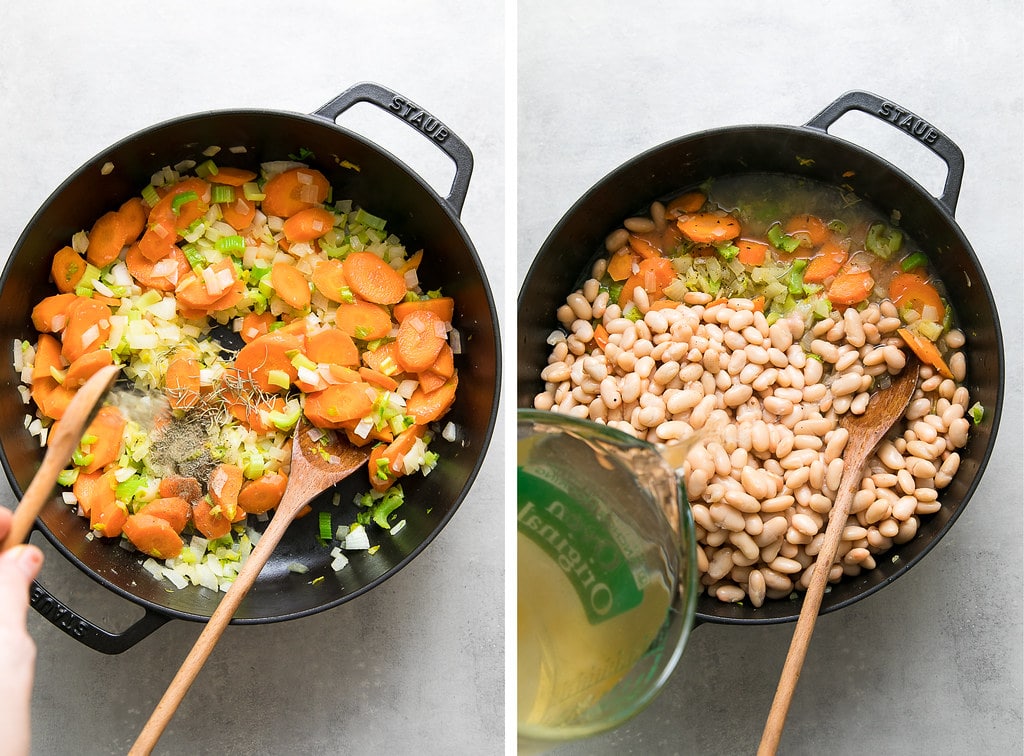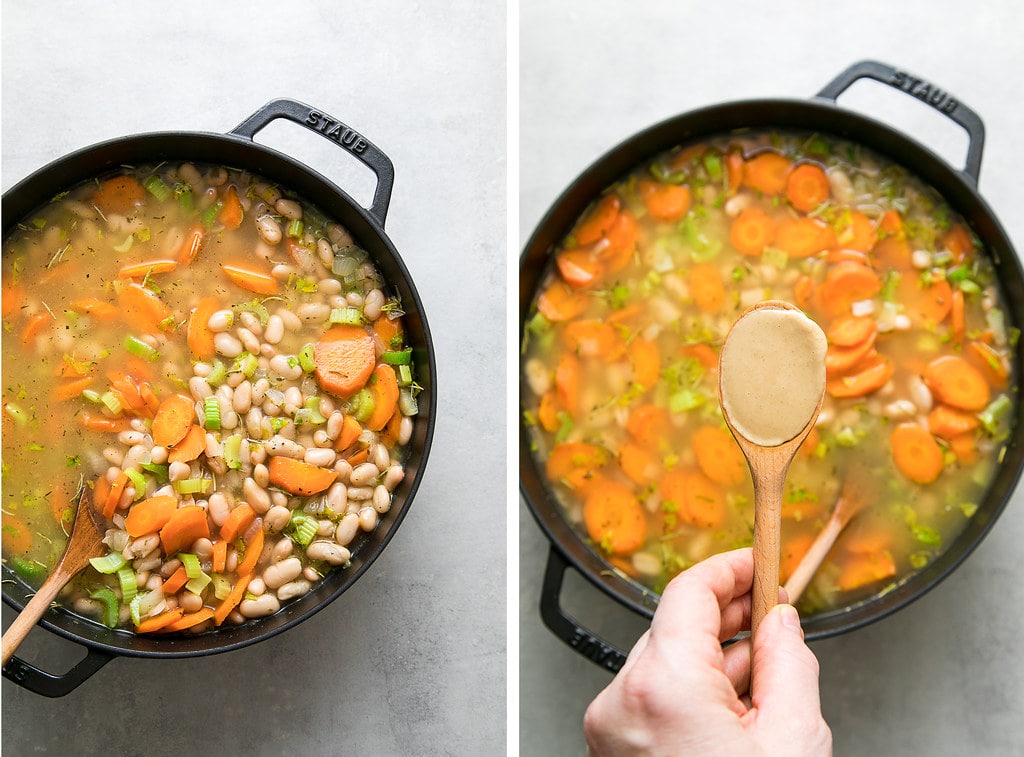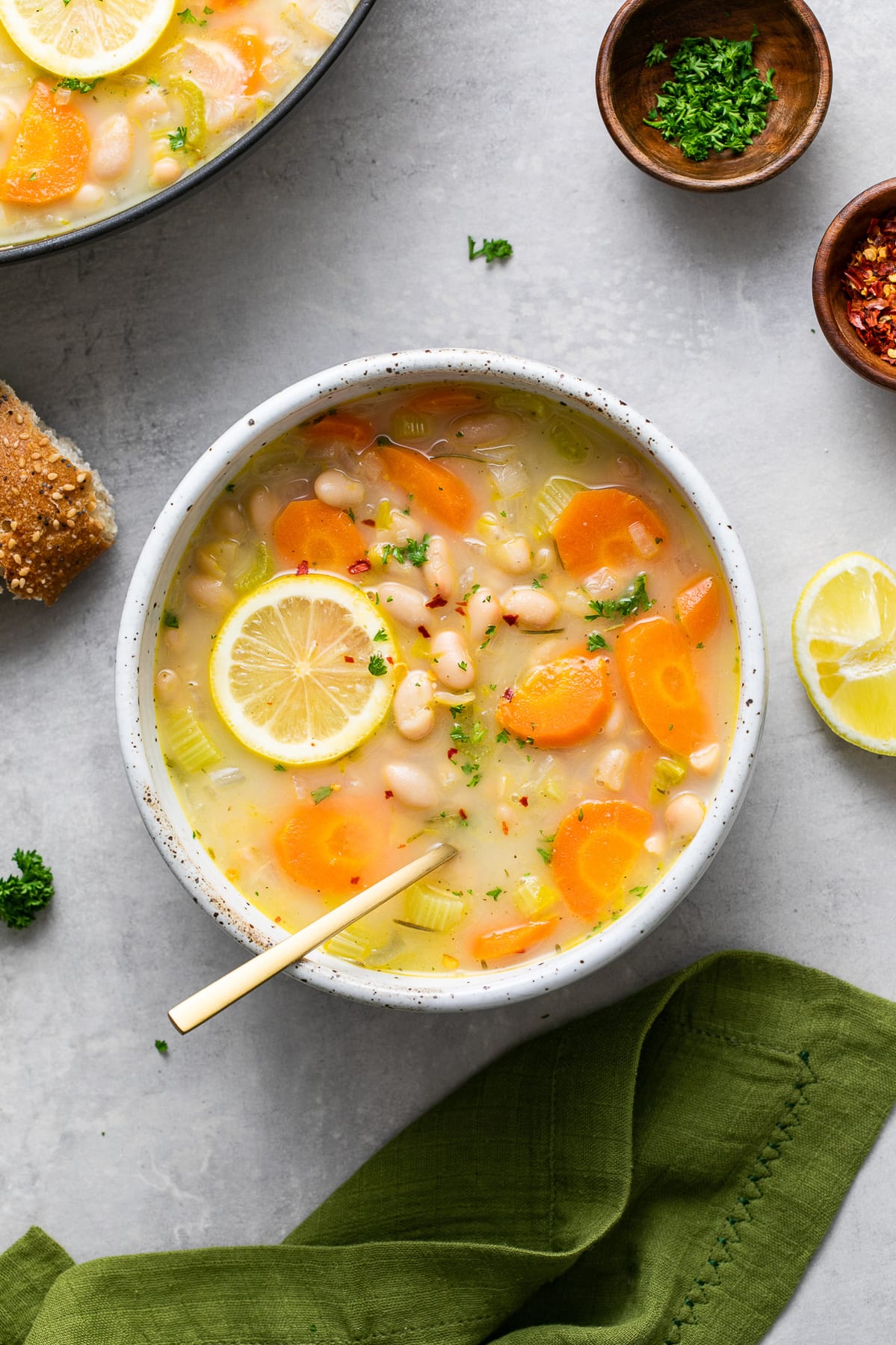Easy Lemon Rosemary White Bean Soup
Easy White Bean Soup with soothing lemon, veggies, rosemary, thyme, and tahini is healthy and easy to make using everyday ingredients that you probably already have on hand! It’s full of nutrition and flavor and is – amazingly delicious!

Don’t let the minimal ingredients in this soup fool you, this vegan white bean soup is so full of deliciousness. Plus, it’s well-balanced, full of healthy protein & fiber, and can be made oil-free!
The hearty texture, subtle combination of flavors, and yummy creaminess from the tahini will leave you wanting more. It’s a perfect pantry-friendly soup that has it all!
This white bean soup is very similar to this highly-rated, fan-favorite Lemon Chickpea Orzo Soup, which uses pasta, spinach, and dill. I simplified the recipe and changed the herbs, but it’s still just as delicious!
So without further ado, let’s make soup!

Ingredients You’ll Need
In this quick and easy recipe, onion, carrots, celery, and garlic are sauteed, then simmered with white beans, herbs, and tahini for a wholesome and healthy soup.
Here is everything you will need, plus ingredient variations:
- White beans – cannellini or great northern beans are preferred, but chickpeas will work too. Even a combo is great!
- Onion – brown or white
- Carrots – I used 3 large carrots for extra heartiness
- Celery – feel free to add in a few celery leaves as well
- Garlic – sub with 1 teaspoon garlic paste or garlic powder
- Thyme + rosemary – dried is fine, but fresh is great too
- Tahini – adds a nice flavor and creaminess, sub with cashew butter (can be optional)
- Vegetable broth – I used 1/2 teaspoon Better Than Bouillon Veg Base (affiliate link) with water.
- Lemon – use lemon for the soup and the other for squeezing into your serving bowl.
- Salt + pepper – to taste

How To Make White Bean Soup
(Note – The full printable recipe is at the bottom of this post)
- In a large pot, heat oil or water over medium heat, add onion, carrots, and celery, and saute for 7 minutes. Add garlic, thyme, and rosemary, and cook for 1 minute more.
- Add the white beans, vegetable broth, and salt + pepper.

- Give a good stir, add the tahini, bring to a boil, reduce heat to low, cover askew, and let simmer for 10 minutes, stirring occasionally.
- Remove from heat, add lemon juice, and let cool a bit before serving (shown below). The broth will thicken upon standing. Season with more salt, pepper, or herbs as desired.
And now all you have to do is enjoy this healthy, luscious soup!
Soup Tips
- Add a few handfuls of spinach at the end of cooking, letting it wilt and soften, for extra color and nutrition.
- The soup will thicken as it cools, that’s if you can wait that long!
- To thicken the soup even more, or if not using tahini, mash some of the beans with the back of a spoon to add creaminess.
- Leftovers are amazing and reheat well.

How to Store and Reheat
Refrigerator: Leftovers can be stored for 5 – 6 days in the refrigerator in a covered container.
Freezer: This white bean soup is freezer-friendly and freezes well for up to 2 – 3 months. To freeze, let cool completely and store in freezer-safe containers (affiliate link), leaving 1/2 inch head space for expansion. You can also freeze larger portions in large ziplock bags (remove as much air as possible before zip-locking). Let thaw before reheating.
Reheat: Simply re-warm on the stovetop over low heat until warmed through. Alternatively, reheat in the microwave using 30 – 60 second intervals, stirring after each, until warm.
Serving Suggestions
To soak up the juices, serve with homemade Artisan Bread, soft and chewy Vegan Naan, or gluten-free Socca flatbread. And, for a soup and salad duo, we recommend this easy House Salad.

More Easy Soup Recipes!
- Lemon Chickpea Orzo Soup
- Vegan Minestrone Soup
- Vegetable Quinoa Soup
- Rustic Cabbage, Potato + White Bean Soup
- Chickpea Noodle Soup
- Garlic Miso Soup with Greens
- Hearty Vegan Lentil Soup

If you try this white bean soup or have a question, please let me know! Leave a comment and rate it below. I love to hear what you think, or any changes you make.
PrintEASY LEMON ROSEMARY WHITE BEAN SOUP
Soothing and wholesome, this hearty white bean soup with lemon, herbs and veggies is healthy, full of flavor and a soup you’ll want to make again and again! Quick and easy recipe, ready in 30 minutes.
- Prep Time: 5 minutes
- Cook Time: 20 minutes
- Total Time: 25 minutes
- Yield: Serves 4 – 6 1x
- Category: Soup, Entree
- Method: simmer
- Cuisine: American
- Diet: Vegan
Ingredients
- 2 tablespoons olive oil or 1/4 cup water
- 1 small onion, diced
- 3 large carrots, sliced or diced
- 2 stalks celery, sliced
- 2 cloves garlic, minced
- 1/2 teaspoon EACH dried thyme + rosemary
- 3 cans (15oz) white beans (cannellini, great northern or chickpeas), drained and rinsed
- 4 – 5 cups low sodium vegetable broth
- 2 tablespoon tahini
- 1 – 2 lemons, juice of 1
- salt + pepper
- fresh chopped parsley, to serve
Instructions
Saute: In a large pot, heat oil or water over medium heat, add onion, carrots, and celery, saute for 7 minutes. Add garlic, thyme and rosemary and cook 1 minute more.
Simmer: Add the white beans, vegetable broth, tahini, and salt + pepper, give a good stir, bring to a boil, reduce heat to low, cover askew, and let simmer for 10 minutes, stirring occasionally.
Add lemon: Remove from heat, add lemon juice and let cool a bit before serving. The broth will thicken upon standing. Season with more salt, pepper or herbs as desired.
Serves 4 – 6
Serve in individual bowls with fresh parsley and squeeze of lemon. Add a sprinkle of red pepper flakes for a little heat.
Pairs well with homemade Artisan Bread and side Classic House Salad.
Store: Leftovers can be kept in the refrigerator for up to 5 – 6 days. For longer storage, keep in the freezer for up to 2 – 3 months. Let thaw before reheating.
Notes
Feel free to use fresh cooked beans, using about 4 1/2 cups. If cooking beans, 2 cups of dried beans, about 1 lb., will yield just the right amount for this soup.
For added color and nutrition, add a handful or two of baby spinach or kale to the soup towards the end of cooking.
For added creaminess, mashing some of the white beans with the back of a spoon will thicken the soup even more.
Instant Pot:
Saute: Use the saute function for 5 minutes; add the oil or water, onion, carrot, celery, and garlic, and set the SAUTE function for 5 minutes, stirring occasionally. In the last minute, add the herbs and continue to sauté.
Cook: Add the beans and vegetable broth, put the lid on and turn to lock, toggle vent to the SEALED position, and manually set the pressure cooker to HIGH for 3 minutes. Let natural release for 10 – 15 minutes. If you do a quick release, be careful of the of the hot steam.
Finish: Turn lid to unlock and remove. Add the tahini, lemon, salt and pepper to taste, and give a good stir. Soup will thicken as it cools.
You can also skip the saute and add everything to the pot, minus the tahini and lemon, and follow the ‘cook‘ directions.
FOLLOW TSV on Facebook, Instagram, Pinterest, Youtube, Subscribe (email), or RSS for more recipes and inspiration!


Have made this multiple times and love it.
Any suggestions to make in instapot? My parents house burnt down and don’t have a pot but they do have an instapot in the trailer they are staying in..
Oh my, sorry to hear and hoping all the best! Yes, this can be made in an Instant Pot. I just updated the NOTES in the recipe card to include making this soup in a pressure cooker. I hope that helps and they enjoy the soup!
Love this soup! I switched up the tahini for peanut butter. Added a few shakes of chili flakes and cooked chicken! Yummy! Thanks for the recipe!
I’m allergic to sesame—is there something else you can recommend that I can use to swap out the tahini?
Yes, you can substitute with our Vegan Creamer instead of tahini to thicken the soup. Also, you can omit it. I hope that helps. Enjoy!
Delicious and healthy soup! The soup is really flavorful and hearty. It is also very pretty! Which I love, especially when I serve it to family and friends!
One of my favorites! Will be making this on a regular basis. Love, love the lemon! Thanks!!